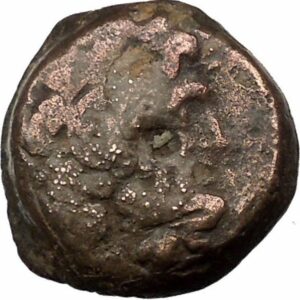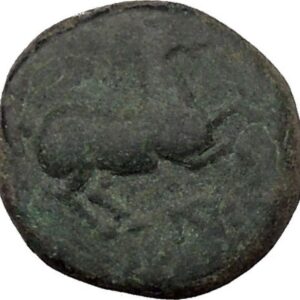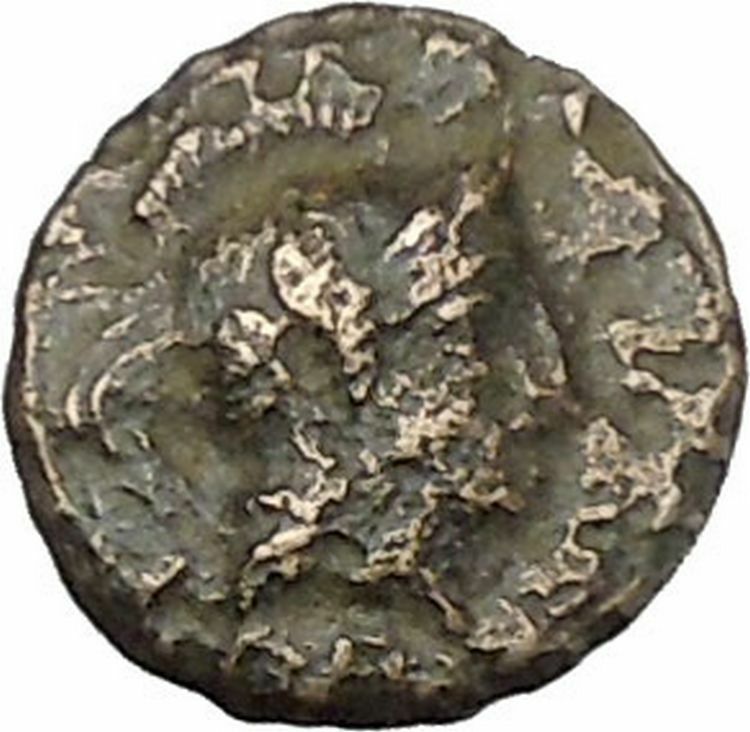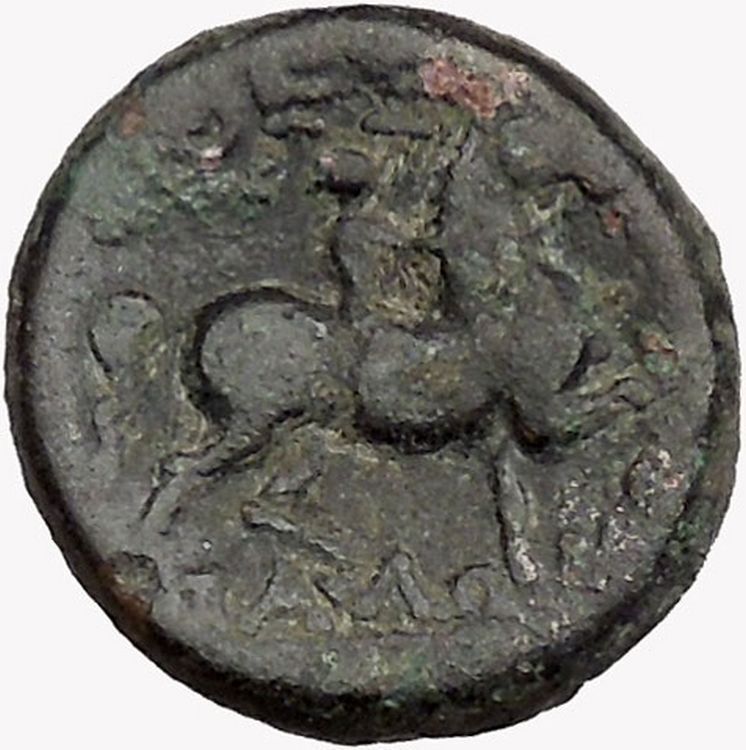|
Greek city of
Apollonia Pontika
of the
Black Sea Area
Bronze 17mm (4.70 grams) Struck circa 3rd-2nd century B.C.
Reference: SNG BM Black Sea 189.
Apollo
seated left on omphalos, holding bow, star
countermark.
EYKYΔHΣ,
Anchor
; A to left, crayfish to right.
A colony of Miletos, the city boasted
a fine temple of Apollo with a statue by the sculptor
Kalamis.
You
are bidding on the exact item pictured, provided with a
Certificate of Authenticity and Lifetime Guarantee of
Authenticity.
Countermarked Coin is a
coin
marked after being
minted and while it is in circulation. Marking can mean
that the coin is fit for circulation or has been
revalued. The latter is the case for countries that
experience rapid changes in
inflation
and need to
quickly change currency valuations. On ancient Greek and
Roman bronze coins, there were ones that circulated so
much and their designs have been therefore worn beyond
recognition. This happened on many coins of emperor
Augustus, whose coins circulated many decades and
sometimes up to a century or more. In order to save
money and energy producing new coins, what the ancients
would do is make an incuse punch with either letters or
symbols. What this allowed is for the coin to continue
circulating because it was officially countermarked to
be a valid coin of the realm. There are many interesting
types of coins with countermarks to collect in ancient
Greek and Roman numismatic coins. What is interesting
about countermarked coins is that they truly have passed
so many hands, that, just to imagine it, could amaze
anyone.

In
Greek
and
Roman mythology
, Apollo
,
is one of the most important and diverse of the
Olympian deities
. The ideal of the
kouros
(a
beardless youth), Apollo has been variously recognized as a god of light and the
sun; truth and prophecy;
archery
;
medicine and healing; music, poetry, and the arts; and more. Apollo is the son
of Zeus
and
Leto, and has a
twin
sister, the chaste huntress
Artemis
.
Apollo is known in Greek-influenced
Etruscan mythology
as Apulu. Apollo was worshiped in both
ancient Greek
and
Roman religion
, as well as in the modern
Greco
–Roman
Neopaganism
.
As the patron of Delphi
(Pythian Apollo), Apollo was an
oracular
god — the prophetic deity of the
Delphic Oracle
.
Medicine and healing were associated with Apollo, whether through the god
himself or mediated through his son
Asclepius
,
yet Apollo was also seen as a god who could bring ill-health and deadly
plague
as well as one who had the ability to cure. Amongst the god’s
custodial charges, Apollo became associated with dominion over
colonists
, and as the patron defender of herds and flocks. As the leader of
the Muses
(Apollon
Musagetes) and director of their choir, Apollo functioned as the patron god
of music and poetry
.
Hermes
created
the lyre
for him,
and the instrument became a common
attribute
of Apollo. Hymns sung to Apollo were called
paeans
.
In Hellenistic times, especially during the third century BCE, as Apollo
Helios he became identified among Greeks with
Helios
,
god of
the sun
, and his sister Artemis similarly equated with
Selene
,
goddess
of the moon
.
In Latin texts, on the other hand, Joseph Fontenrose declared himself unable to
find any conflation of Apollo with
Sol
among the
Augustan poets
of the first century, not even in the conjurations of
Aeneas
and
Latinus
in
Aeneid
XII
(161–215).
Apollo and Helios/Sol remained separate beings in literary and mythological
texts until the third century CE.
Mariner’s
Cross
The Mariner’s Cross is a stylized cross in the shape of an
anchor
. The
Mariner’s Cross
is also referred to as
Saint Clement’s Cross
in reference to the
way he was martyred.
The Anchored Cross, or
Mariner’s Cross
, is a stylized cross in the
shape of an anchor. It is a symbol which is shaped like a plus sign with
anchor
-like protrusions at the end of each arm,
hence the name Anchored Cross. The symbol can be used to signify ‘fresh start’
or ‘hope’.
Cross and Anchor are occasionally a feature of
coats of arms
in which context they are
referred to by the
heraldic
terms anchry or ancre.
The Mariner’s Cross is also referred to as
St. Clement’s Cross
in reference to the way he
was martyred.
The History of the
anchor
dates back millennia. The most
ancient anchors were probably rocks and many rock anchors have been found dating
from at least the
Bronze Age
. Many modern moorings still rely on
a large rock as the primary element of their design. However, using pure mass to
resist the forces of a
storm
only works well as a permanent mooring;
trying to move a large enough rock to another bay is nearly impossible.
The ancient Greeks used baskets of stones, large sacks filled with sand, and
wooden logs filled with lead, which, according to
Apollonius Rhodius
and
Stephen of Byzantium
, were formed of stone; and
Athenaeus
states that they were sometimes made
of wood. Such anchors held the vessel merely by their weight and by their
friction
along the bottom. Iron was afterwards
introduced for the construction of anchors, and an improvement was made by
forming them with teeth, or “flukes”, to fasten themselves into the bottom.
An anchor frequently appears on the flags and coats of arms of institutions
involved with the sea, both naval and commercial, as well as of port cities and
seacoast regions and provinces in various countries. There also exists in
heraldry the “Anchored Cross”, or Mariner’s Cross, a stylized cross in the shape
of an anchor. The symbol can be used to signify ‘fresh start’ or ‘hope’. The
Mariner’s Cross is also referred to as St. Clement’s Cross, in reference to the
way this saint was martyred (being tied to an anchor and thrown from a boat into
the Black Sea in 102). Anchored crosses are occasionally a feature of coats of
arms in which context they are referred to by the heraldic terms anchry or ancre.

A 1914 Russian poster depicting the
Triple Entente
. Britannia’s
association with the oceanic
British Empire
is indicated by her
holding a large anchor.
The anchor coinage was a series of four denominations of
silver coins
issued for use in some British
colonies in 1820 and 1822. The name comes from the crowned
anchor
that appears on the obverse of the
coins. The denominations were sixteenth, eighth, quarter and half dollars,
indicated by the Roman numerals XVI, VIII, IV and II on each side of the anchor.
The reverse design was the royal coat of arms.
According to Krause & Mishler’s Standard Catalog of World Coins,the
coins were issued for use in
Mauritius
and other Indian Ocean colonies, then
later circulated in the
West Indies
.
Sozopol (Bulgarian:
Созопол) is an
ancient town and seaside resort located 35
km
south of
Burgas
on the southern
Black Sea Coast
of
Bulgaria
. Today the town is mostly a seaside resort
known for the Apollonia art and film festival
(which takes place in early September) and is named
after one of Sozopol’s ancient names.
The busiest times of the year are the summer months,
ranging from May to September as tourists from around
the world come to enjoy the weather, sandy beaches,
history and culture, fusion cuisine (Bulgarian, Greek,
Turkish), and atmosphere of the colourful resort. The
increasing popularity of the town has led to it being
dubbed the Bulgarian
St. Tropez
, seeing stars like
Ralph Fiennes
,
Brad Pitt
,
Angelina Jolie
and
Goldfrapp
exploring its beauty and charm.
Part of
Burgas Province
, as of September 2005[update]
Sozopol has a population of 4,641. The town is located
at
 42.417°N 42.417°N
27.7°E /
42.417; 27.7
/ 42°25′N
27°42′E
and the mayor is Panaiot Reyzi. One of the most active
and popular mayors had been
Nikola Kaloyanov
, who initiated numerous
infrastructure changes to modernize the town in the 70s.
//
History
Sozopol is one of the oldest towns on
Bulgarian Thrace
‘s
Black Sea
coast. The first settlement on the site
dates back to the
Bronze Age
. Undersea explorations in the region of
the port reveal relics of dwellings, ceramic pottery,
stone and bone tools from that era. Many anchors from
the second and first millennium BC have been discovered
in the town’s bay, a proof of active shipping since
ancient times.
The town, at first called Antheia, was
colonized in Thrace on the shore of the Pontus Euxinus,
principally on a little island, by
Anaximander
(born 610-609 BC) at the head of
Milesian
colonists. The name was soon changed to
Apollonia, on account of a temple dedicated to
Apollo
in the town, containing a famous colossal
statue of the god Apollo by
Calamis
, 30 cubits high, transported later to Rome
by
Lucullus
and placed in the
Capitol
. At various times, Apollonia was known as
Apollonia Pontica (that is, Apollonia on the
Black Sea, the ancient Pontus Euxinus) and
Apollonia Magna (Great Apollonia).
The coins, which begin in the fourth century BC, bear
the name Apollonia and the image of Apollo; the imperial
coins, which continue to the first half of the third
century AD, and the
Tabula Peutinger
also contain the name Apollonia;
but the “Periplus
Ponti Euxini“, 85, and the
Notitiæ episcopatuum
have only the new name
Sozopolis. In 1328 Cantacuzene (ed. Bonn, I, 326) speaks
of it as a large and populous town. The islet on which
it stood is now connected with the mainland by a narrow
tongue of land. Sozopolis, in Greek Sozòpolis (Σωζωπολις,
meaning the “preserve” city), in Turkish Sizebolu,
in Bulgarian Sozopol, is in Burgas Province,
Bulgaria. Its inhabitants, in the past mostly Greeks,
lived by fishing and agriculture.
The town established itself as a trade and naval
centre in the following centuries. It kept strong
political and trade relations with the cities of
Ancient Greece
–
Miletus
,
Athens
,
Corinth
,
Heraclea Pontica
and the islands
Rhodes
,
Chios
,
Lesbos
, etc. Its trade influence in the
Thracian territories
was based on a treaty with the
rulers of the
Odrysian kingdom
dating from the fifth century BC.
The symbol of the town – the anchor, present on all
coins minted by Apollonia since the sixth century BC, is
proof of the importance of its maritime trade. The rich
town soon became an important cultural centre. At these
times it was called Apollonia Magna.
Ruled in turn by the
Byzantine
,
Bulgarian
and
Ottoman
Empires, Sozopol was assigned to the newly
independent Bulgaria in the 19th century. Almost all of
its
Greek population
was exchanged
with Bulgarians from
Eastern Thrace
in the aftermath of the
Balkan Wars
.
Ecclesiastical
history
Sozopol was Christianized early. Bishops are recorded
as resident there from at least 431. At least eight
bishops are known (Le
Quien, Oriens christianus, I, 1181):
Athanasius (431), Peter (680), Euthymius (787) and
Ignatius (869); Theodosius (1357), Joannicius, who
became
Patriarch of Constantinople
(1524), Philotheus
(1564) and Joasaph (1721).
From being
suffragan
to the
archbishopric of Adrianopolis
, it became in the
fourteenth century a
metropolis
without suffragan sees; it disappeared
perhaps temporarily with the Turkish conquest, but
reappeared later; in 1808 it was united to the See of
Agathopolis
. The titular resided at
Agathopolis
, in Ottoman days called Akhtébolou, in
the
vilayet
of
Adrianopolis
(Edirne, in European Turkey).
Eubel
(Hierarchia catholica medii ævi, I,
194) mentions four Latin bishops of the fourteenth
century.
The city remains a
titular see
of the Roman Catholic Church, that of
Sozopolis in Haemimonto, suffragan of Adrianopolis.
The seat has stood vacant since the death of the last
titular bishop in 2000.[2]
Art flourished in the Christian era. The ancient
icons and magnificent woodcarving in the
iconostases
are a remarkable accomplishment of the
craftsmanship of these times. The architecture of the
houses in the old town from the
Renaissance period
makes it a unique place to visit
today.
Names
The original name of the city is attested as
Antheia.[3]
Coins were minted in the town bearing the inscription
Apollonia, which date from the sixth century BC to the
first half of the third century AD. During this period,
appellations such as Apollonia Pontica (Apollonia
on the Black Sea) and Apollonia Magna (Great
Apollonia) have been recorded. By the first century
AD, the name Sozopolis began to appear in written
records (e.g., in the
Periplus Ponti Euxini
). After the town became
part of the Ottoman Empire, the name was Turkified to
Sizeboli, Sizebolu or Sizebolou. After
Bulgaria took possession of the town, it was Slavicized
to Sozopol.
Sozopol Gap
on
Livingston Island
in the
South Shetland Islands
,
Antarctica
is named after Sozopol.
|











